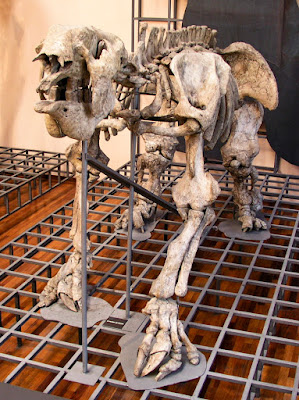As a disclaimer: The story below is simply me relaying the facts. I do not have any stake in how these facts are interpreted or the validity of the published or reported facts.
The Natural History Museum in London has a page on the internet dedicated to Megatherium and it asks, quite simply, at the top "What was Megatherium?" Rather than starting with an outright answer, the museum explains why it would even ask that question by telling you the connection between London and a South American fossil sloth: two of Darwin's fossils (the last two digitized in the NMH collection) are halves of a Megatherium skull. Megatherium was actually well known before Darwin took the fossil skull from its home continent. The first fossils had been unearthed in 1788 by Manuel Torres, who sent them from the Lujan area west of Buenos Aires near the Lujan River of Argentina to the Museo de Ciencias Naturales of Madrid. Modern day Lujan appears to be rather far from the river, though changes in the urban landscape around Buenos Aires may account for this (I have found no record of the river changing course in my, admittedly, short search). These actually made up, as seen here, what is considered the first mounted fossil skeleton in a museum (circa 1795).
Despite having been discovered in 1788 in Argentina, official description of this fossil mammal was not produced until 1796. This publication resulted from an interpretation by Georges Cuvier, a French naturalist, of a series of drawings and descriptions of the bones by Juan Bautista Bru, a museum employee and also a dissector of the Royal Laboratory, who had helped to assemble and mount the skeleton. It is argued by Lopez Piñero (1988) that Bru's work with Megatherium and the description for the museum should count as the original description. Lopez Piñero goes on to state that an agent of the French government, a man named Roume, obtained copies of Bru's plates while in Madrid, sent them back to France, and the Institut de France asked Cuvier to write a description of what Cuvier would later state were "a bad copy of the... whole skeleton." As insulting as this may have been (not to mention that a South American animal was sent to Spain to be described in the first place), when the description was sent to Spain to be translated into Spanish, it was discovered that Bru's highly detailed description already existed. It was published almost immediately, but in the years after, Cuvier incorporated a French translation of Bru's description into his 1812 opus (Recherches sur les ossements fossil) and Bru was all but forgotten in the history of Megatherium.
Argot (2008) reports that Cuvier changed his hypotheses about the lifestyle of the sloth a number of times. First he stated that the animal, like modern sloths, must have climbed trees. Later he changed his assertions, claiming the animal was a fossorial, or underground, animal somewhat like a mole. Darwin sated the British museum's desire for some Megatherium fossil material in later years, but he never mentioned Bru. Even Tomas Villanova, a professor of zoology at the museum in Madrid, refused to refute Cuvier's description, or his hypotheses, and would not give Bru credit. Megatherium has had, as many fossils did, a very interesting history.
Literature Cited
Argot, C. (2008). "Changing Views in Paleontology: The Story of a Giant (Megatherium, Xenarthra)". In Sargis, E. J.; Dagosto, M. (eds.). Mammalian Evolutionary Morphology: A Tribute to Frederick S. Szalay. Springer. pp. 37–50.
Cuvier, G. (1812). Recherches sur les ossements fossils, oú l'on rétablit les charactères de plusiers animaux dont les révolutions du globe ont dé-truit. Tome quatrieme. Troisiéme partie. Sur les ossemens fossils de ruminans. Chez G. Dufour et E. D'Ocagne, Libraries, Paris, France.
Lopez Piñero, J. M. (1988). Juan Bautista Bru (1740–1799) and the description of the genus Megatherium. J Hist Biol 21:147–63.


No comments:
Post a Comment